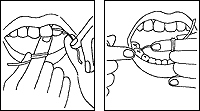If you have diabetes, you know the disease can harm your eyes, nerves, kidneys, heart and other important systems in the body. Did you know it can also cause problems in your mouth? People with diabetes have a higher than normal risk of periodontal diseases.
Periodontal diseases are infections of the gum and bone that hold the teeth in place. In advanced stages, they lead to painful chewing problems and even tooth loss. Like any infection, gum disease can make it hard to keep your blood sugar under control.
What is the Link Between Diabetes and Periodontal Disease?
- Diabetic Control.
Like other complications of diabetes, gum disease is linked to diabetic control. People with poor blood sugar control get gum disease more often and more severely, and they lose more teeth than do persons with good control. In fact, people whose diabetes is well controlled have no more periodontal disease than persons without diabetes. Children with IDDM (insulin-dependent diabetes mellitus) are also at risk for gum problems. Good diabetic control is the best protection against periodontal disease.
Studies show that controlling blood sugar levels lowers the risk of some complications of diabetes, such as eye and heart disease and nerve damage. Scientists believe many complications, including gum disease, can be prevented with good diabetic control.
- Blood Vessel Changes
Thickening of blood vessels is a complication of diabetes that may increase risk for gum disease. Blood vessels deliver oxygen and nourishment to body tissues, including the mouth, and carry away the tissues' waste products. Diabetes causes blood vessels to thicken, which slows the flow of nutrients and the removal of harmful wastes. This can weaken the resistance of gum and bone tissue to infection.
- Bacteria
Many kinds of bacteria (germs) thrive on sugars, including glucose -- the sugar linked to diabetes. When diabetes is poorly controlled, high glucose levels in mouth fluids may help germs grow and set the stage for gum disease.
- Smoking
The harmful effects of smoking, particularly heart disease and cancer, are well known. Studies show that smoking also increases the chances of developing gum disease. In fact, smokers are five times more likely than nonsmokers to have gum disease. For smokers with diabetes, the risk is even greater. If you are a smoker with diabetes, age 45 or older, you are 20 times more likely than a person without these risk factors to get severe gum disease.
How Does Periodontal Disease Develop?
- Gingivitis
Poor brushing and flossing habits allow dental plaque -- a sticky film of germs -- to build up on teeth. Some of these germs cause gum disease. The gums can become red and swollen and may bleed during toothbrushing or flossing. This is called gingivitis, the first stage of periodontal disease.
Gingivitis can usually be reversed with daily brushing and flossing and regular cleanings by the dentist. If it is not stopped, gingivitis could lead to a more serious type of gum disease called periodontitis.
- Periodontitis
Periodontitis is an infection of the tissues that hold the teeth in place. In periodontitis, plaque builds and hardens under the gums. The gums pull away from the teeth, forming "pockets" of infection. The infection leads to loss of the bone that holds the tooth in its socket and might lead to tooth loss.

As plaque builds up, the gums become inflamed and, in time, affected teeth may loosen and could be lost.There are often no warning signs of early periodontitis. Pain, abscess, and loosening of the teeth do not occur until the disease is advanced. Since periodontitis affects more than just the gums, it cannot be controlled with regular brushing and flossing. Periodontitis should be treated by a periodontist (a gum disease specialist) or by a general dentist who has special training in treating gum diseases.
How Is Periodontal Disease Treated?
- Plaque Removal
Treatment of periodontitis depends on how much damage the disease has caused. In the early stages, the dentist or periodontist will use deep cleaning to remove hardened plaque and infected tissue under the gum and smooth the damaged root surfaces of teeth. This allows the gum to re-attach to the teeth. A special mouthrinse or an antibiotic might also be prescribed to help control the infection.
Deep cleaning is successful only if the patient regularly brushes and flosses to keep the plaque from building up again.
- Periodontal Surgery
Gum surgery is needed when periodontitis is very advanced and tissues that hold a tooth in place are destroyed. The dentist or periodontist will clean out the infected area under the gum, then reshape or replace the damaged tooth-supporting tissues. These treatments increase the chances of saving the tooth.
If You Have Diabetes...
- It's important for you to know how well your diabetes is controlled and to tell your dentist this information at each visit.
- See your doctor before scheduling treatment for periodontal disease. Ask your doctor to talk to the dentist or periodontist about your overall medical condition before treatment begins.
- You may need to change your meal schedule and the timing and dosage of your insulin if oral surgery is planned.
- Postpone non-emergency dental procedures if your blood sugar is not in good control. However, acute infections, such as abscesses, should be treated right away.
For the person with controlled diabetes, periodontal or oral surgery can usually be done in the dentist's office. Because of diabetes, healing may take more time. But with good medical and dental care, problems after surgery are no more likely than for someone without diabetes.
Once the periodontal infection is successfully treated, it is often easier to control blood sugar levels.
Are Other Oral Problems Linked to Diabetes?
- Dental Cavities
Young people with IDDM have no more tooth decay than do nondiabetic children. In fact, youngsters with IDDM who are careful about their diet and take good care of their teeth often have fewer cavities than other children because they don't eat many foods that contain sugar.
- Thrush
Thrush is an infection caused by a fungus that grows in the mouth. People with diabetes are at risk for thrush because the fungus thrives on high glucose levels in saliva. Smoking and wearing dentures (especially when they are worn constantly) can also lead to fungal infection. Medication is available to treat this infection. Good diabetic control, no smoking, and removing and cleaning dentures daily can help prevent thrush.
- Dry Mouth.
Dry mouth is often a symptom of undetected diabetes and can cause more than just an uncomfortable feeling in your mouth. Dry mouth can cause soreness, ulcers, infections, and tooth decay.
The dryness means that you don't have enough saliva, the mouth's natural protective fluid. Saliva helps control the growth of germs that cause tooth decay and other oral infections. Saliva washes away sticky foods that help form plaque and strengthens teeth with minerals.
One of the major causes of dry mouth is medication. More than 400 over-the-counter and prescription drugs, including medicines for colds, high blood pressure or depression, can cause dry mouth. If you are taking medications, tell your doctor or dentist if your mouth feels dry. You may be able to try a different drug or use an "artificial saliva" to keep your mouth moist.
Good blood glucose control can help prevent or relieve dry mouth caused by diabetes.
- Keep Your Teeth
Serious periodontal disease not only can cause tooth loss, but can also cause changes in the shape of bone and gum tissue. The gum becomes uneven, and dentures may not fit well. People with diabetes often have sore gums from dentures.
If chewing with dentures is painful, you might choose foods that are easier to chew but not right for your diet. Eating the wrong foods can upset blood sugar control. The best way to avoid these problems is to keep your natural teeth and gums healthy.
How Can You Protect Your Teeth and Gums?
Harmful germs attack the teeth and gums when plaque builds up. You can stop plaque build-up and prevent gum disease by brushing and flossing carefully every day.

- Use a piece of dental floss about 18 inches long.
- Using a sawing motion, gently bring the floss through the tight spaces between the teeth.
- Do not snap the floss against the gums.
- Curve the floss around each tooth and gently scrape from below the gum to the top of the tooth several times.
- Rinse your mouth after flossing.

- Gently brush teeth twice a day with a soft nylon brush with rounded ends on the bristles.
- Avoid hard back-and-forth scrubbing.
- Use small circle motions and short back-and-forth motions.
- Gently brush your tongue, which can trap germs.
- Use a fluoride toothpaste to protect teeth from decay.
Dental plaque is hard to see unless it is stained. Plaque can be stained by chewing red "disclosing tablets" sold at grocery stores and drug stores or by using a cotton swab to smear green food coloring on the teeth. The color left on the teeth shows where there is still plaque. Extra flossing and brushing will remove this plaque.
People with diabetes should have dental check-ups at least every 6 months, or more often if recommended by their dentist. Be sure to tell your dentist you have diabetes. Frequent dental check-ups are needed to find problems early when treatment is most effective. See your dentist as soon as possible if you have any problem with your teeth or mouth.
Preventing or controlling gum disease depends on teamwork. The best defense against this complication of diabetes is good blood sugar control, combined with daily brushing and flossing and regular dental check-ups.
National Institute of Dental and Craniofacial Research








